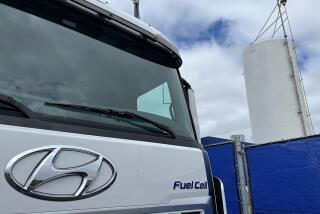Energy firm floats gas terminal plan
A small energy company is the latest to propose a liquefied natural gas terminal in Southern California, detailing a plan Wednesday for two floating platforms about 10 miles southwest of Huntington Beach.
As envisioned by Esperanza Energy, a subsidiary of Tidelands Oil and Gas Corp. of San Antonio, the terminals would be located in 1,100 feet of water, among a set of existing oil platforms. The facility, to be called Port Esperanza, would transform the super-chilled liquid fuel back into vapor and then pump it ashore through pipelines.
The proposal comes six weeks after Long Beach officials pulled the plug on plans for an $800-million natural gas terminal in the Port of Long Beach after safety concerns proved insurmountable. Sound Energy Solutions, a partnership with ConocoPhillips and Mitsubishi Corp. that is proposing the port terminal, last month sued to force the Long Beach Harbor Board of Commissioners to revive the project.
The proposal also comes just weeks before the Coast Guard is expected to release the final environmental impact report on BHP Billiton’s proposed gas facility offshore near Oxnard, a plan that has drawn significant local opposition.
Given the strength of the resistance to the half a dozen other plans, Esperanza executives studied all of the West Coast proposals for liquefied natural gas operations to learn from their mistakes.
“Our goal was to not pursue a project unless we were convinced that we could do it better than anyone else,” said Terry Mitchell, an Esperanza vice president.
The company, which first signaled its interest in building an offshore terminal in April, took pains to point out the ways its proposal addressed past community concerns. No gas would be stored at the facility, for example, and no pollutants would be emitted as part of the regasification process.
Harvey Morris, assistant general counsel for the California Public Utilities Commission, said that Esperanza addressed one of the commission’s “major concerns”: that an LNG facility shouldn’t be located in or near densely populated areas.
“This project, like three others, is located in federal offshore waters at least 10 miles from land and, under our experts’ views, would pose no safety risk to people onshore,” Morris said.
But Esperanza’s efforts didn’t calm all of the waters.
“It doesn’t really change our position, which is that we don’t need it, whatever it is,” said Rory Cox, California program director for San Francisco-based Pacific Environment. Cox said that the environmental group disagreed with a 2003 California Energy Commission study that determined California would need the resources of at least one and perhaps two West Coast LNG terminals.
Others said the latest project highlighted the need to consider these plans collectively rather than proposal by proposal.
“What we have been asking the state to do is to compare all of the proposed LNG projects,” said Linda Krop, chief counsel for the Environmental Defense Center. “Until we get that kind of information, it’s hard to make an analysis.”
The heart of the Esperanza proposal, Mitchell said, are two floating machines that are half the size of a yard crane at the port of Los Angeles or Long Beach, projecting about 100 feet above the water. They would be anchored to the bottom and maneuvered alongside an arriving ship by using onboard electrically powered thrusters. Once attached to the ship with suction cups, they would draw liquefied gas from the ship.
Esperanza intends to use warm water discharged by a power plant to warm the LNG and turn it back into gas, Mitchell said. It then would travel by pipeline to shore, where it would tie into Southern California Gas Co.’s distribution network.
“We would generate no air emissions with our terminals. We will locate in an industrial area near existing oil platforms and they would be very difficult to see from the shore,” Mitchell said.
Mitchell did not estimate the facility’s cost but said it would be comparable to other West Coast proposals -- about $800 million. The facility would process as much as 1.2 billion cubic feet of natural gas a day. In 2005, Californians consumed nearly 6 billion cubic feet of natural gas a day, according to the California Energy Commission.
Esperanza expects to submit formal proposals as early as the end of 2007.
The project will require approvals from the state’s Public Utilities, Lands and Coastal commissions and the Coast Guard.
*
More to Read
Sign up for Essential California
The most important California stories and recommendations in your inbox every morning.
You may occasionally receive promotional content from the Los Angeles Times.











